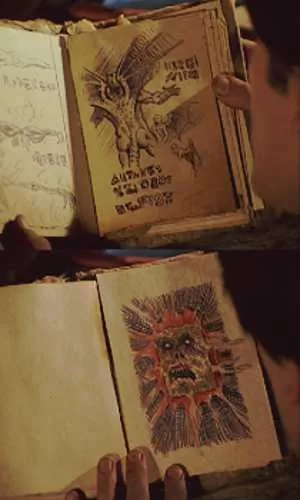The Necronomicon is one of the most infamous and mysterious books in fiction and occult lore. Born from the mind of horror writer H.P. Lovecraft, this fictional grimoire has taken on a life of its own, inspiring countless stories, films, and conspiracy theories. While Lovecraft originally invented the Necronomicon as part of his universe of cosmic horror, many have come to believe that the book holds real power or that it may even exist in some secret form.
What exactly is the Necronomicon? What is its place in Lovecraft’s works, and how did it become so deeply ingrained in pop culture and occult circles? In this article, we explore the origins, content, and impact of the Necronomicon, while also separating fact from fiction in the strange history of this legendary book.
The Origins of the Necronomicon
The Necronomicon first appeared in the works of H.P. Lovecraft, an early 20th-century American author known for his dark and otherworldly horror stories. In Lovecraft’s fictional mythos, the Necronomicon is described as a tome of forbidden knowledge, written by the “Mad Arab” Abdul Alhazred. The book is said to contain rituals, spells, and incantations that allow readers to summon ancient and malevolent beings from beyond the known universe.

Lovecraft introduced the Necronomicon in his 1924 short story, “The Hound,” and it quickly became a recurring element in his other works. Lovecraft himself wrote that the book was entirely fictional, created as a literary device to enhance the sense of dread and cosmic horror that pervades his stories. However, the allure of the Necronomicon was so strong that readers began to ask if the book was real, with some even claiming to have seen copies of it in old libraries or private collections.
The Content of the Necronomicon
In Lovecraft’s mythos, the Necronomicon is said to contain dangerous knowledge, including the history of the Old Ones—ancient, god-like beings who once ruled the Earth and who wait in slumber to reclaim their dominion. The book is described as a guide to communicating with these entities, as well as a compendium of spells, alchemical formulas, and occult symbols.

While Lovecraft never wrote out the full contents of the Necronomicon, he provided tantalizing glimpses of its pages in his stories. In The Dunwich Horror, for example, a character named Dr. Armitage uses the Necronomicon to banish a monstrous entity summoned by the story’s antagonist. In The Call of Cthulhu, the book is mentioned as a source of knowledge about the titular ancient being, Cthulhu.
The spells and incantations in the Necronomicon are said to be so dangerous that merely reading them can drive a person mad. Lovecraft emphasized the book’s forbidden nature, often depicting it as a cursed object sought by power-hungry individuals who inevitably meet terrible fates.
The Creation of the Necronomicon
Lovecraft enjoyed crafting elaborate backstories for the Necronomicon and its author. He claimed that Abdul Alhazred wrote the book around 700 AD in Damascus and that it was originally titled Al-Azif, a reference to the nocturnal sounds made by insects, which the Arabs believed to be the howling of demons. After Alhazred’s mysterious death, the book was translated into Greek in the 10th century and given the title Necronomicon, meaning “the book of dead names.”
Lovecraft invented a history for the Necronomicon, claiming that it was banned by various religious authorities, including the Catholic Church, and that only a few copies of the book remained, hidden in secret libraries like the Vatican or Miskatonic University (a fictional institution in Lovecraft’s stories). This elaborate backstory added to the allure and mystery of the Necronomicon, making it seem more real than a mere literary invention.
The Necronomicon’s Influence on Popular Culture
Lovecraft’s Necronomicon quickly became a cultural phenomenon, far surpassing its origins as a fictional element in his stories. Since Lovecraft’s death in 1937, the Necronomicon has appeared in a wide range of media, including films, books, video games, and music. Perhaps most famously, the book is featured in the Evil Dead film series, where it is depicted as a demonic text bound in human flesh and inked in blood. This version of the Necronomicon has become iconic in its own right, further cementing the book’s status as a pop culture legend.

Numerous authors and filmmakers have expanded on Lovecraft’s mythos, creating their own interpretations of the Necronomicon. Some have written entire books purporting to be “real” versions of the text, often blending Lovecraft’s fictional elements with genuine occult practices. These “real” Necronomicons have been published by various occult presses and are often presented as authentic grimoires, though most scholars regard them as hoaxes or works of creative fiction.
Despite its fictional origins, the Necronomicon has also become a symbol in occult circles. Some practitioners of modern-day magic and esotericism claim that the book contains real knowledge, hidden within Lovecraft’s writings as a form of coded wisdom. While there is no evidence to support these claims, the idea of the Necronomicon as a source of hidden power continues to fascinate and inspire those interested in the darker aspects of the occult.
The Search for the Real Necronomicon
Over the years, numerous individuals have claimed to have found or created real versions of the Necronomicon. These include the so-called Simon Necronomicon, published in 1977 by a man known only as Simon. This version of the book blends elements of Lovecraft’s mythos with Sumerian mythology, presenting itself as a legitimate grimoire for summoning ancient gods and performing magic.
Other purported Necronomicons have surfaced in various forms, including texts inspired by medieval grimoires and books claiming to contain rituals from ancient sources. However, these books are typically regarded as hoaxes or fictional interpretations, rather than legitimate ancient texts.
Despite this, the Necronomicon continues to hold a powerful grip on the imagination of those who seek out arcane knowledge. The book’s reputation as a dangerous and forbidden text has only grown over time, even as scholars debunk the idea of its existence outside of fiction. In some ways, the Necronomicon has transcended its origins, becoming a symbol of the search for forbidden knowledge and the risks associated with delving too deeply into the unknown.
The Legacy of the Necronomicon
The Necronomicon remains one of the most enduring creations in Lovecraft’s mythos, a testament to his ability to blend horror, fantasy, and mythology into something that feels both timeless and terrifying. While the book itself may be fictional, its impact on popular culture and the occult community is very real.
The enduring appeal of the Necronomicon lies in its ability to tap into humanity’s primal fears and desires. The book represents the ultimate forbidden knowledge—the key to unlocking the mysteries of the universe, but at a terrible cost. This theme resonates with readers and creators alike, inspiring new stories, films, and theories that continue to expand the mythos surrounding the Necronomicon.
As long as people remain fascinated by the unknown and the boundaries of human knowledge, the Necronomicon will continue to haunt the imagination. Whether viewed as a literary invention or a symbol of something darker, the book’s legacy is secure as one of the most intriguing and mysterious artifacts of modern horror.
Conclusion
While the Necronomicon may have started as a fictional creation in Lovecraft’s universe, it has since become a cultural phenomenon that transcends its origins. From horror films to occult books, the Necronomicon has taken on a life of its own, embodying the allure of forbidden knowledge and the dangers that come with seeking power beyond human comprehension.
Whether or not the Necronomicon exists in any real form is ultimately irrelevant. What matters is the impact it has had on popular culture and the way it has shaped our understanding of horror, the occult, and the limits of human knowledge. Lovecraft’s creation continues to inspire and terrify, proving that sometimes, the most powerful ideas are the ones we can’t quite define—or fully control.
